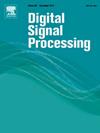Adaptive polarimetric persymmetric detection for distributed subspace targets in lognormal texture clutter
IF 2.9
3区 工程技术
Q2 ENGINEERING, ELECTRICAL & ELECTRONIC
引用次数: 0
Abstract
In this paper, the adaptive polarimetric persymmetric detection for distributed subspace targets under the background of compound Gaussian clutter is investigated, where the compound Gaussian clutter exhibits texture that follows a lognormal distribution. Based on the two-step Generalized Likelihood Ratio Test (2S GLRT), two-step maximum a posteriori Generalized Likelihood Ratio Test (2S MAP GLRT), two-step Rao (2S Rao) test and two-step Wald (2S Wald) test, we have proposed four polarimetric persymmetric detectors. Initially, we model the target echo as a distributed subspace signal, assuming known clutter texture and polarization speckle covariance matrix (PSCM), and derive the corresponding test statistics. Then, the estimation of the lognormal texture is obtained through maximum a posteriori (MAP). Conventionally, a set of secondary data, which share the same PSCM as the cells under test (CUTs), is assumed to participate in the estimation of the PSCM, leveraging its inherent persymmetric property during the estimation process. Finally, the estimated values are substituted into the proposed test statistics to obtain fully adaptive polarimetric persymmetric detectors. Numerical experimental results using simulated data and measured sea clutter data demonstrate that the proposed four adaptive polarimetric persymmetric detectors exhibit a constant false alarm rate (CFAR) characteristic relative to the PSCM and satisfactory detection performance for distributed subspace targets.
对数正态纹理杂波中分布式子空间目标的自适应偏振不对称检测
本文研究了在复合高斯杂波背景下分布式子空间目标的自适应偏振持续对称检测,其中复合高斯杂波的纹理服从对数正态分布。基于两步广义似然比检验(2S GLRT)、两步最大后验广义似然比检验(2S MAP GLRT)、两步 Rao 检验(2S Rao)和两步 Wald 检验(2S Wald),我们提出了四种极性不对称检测器。首先,我们将目标回波建模为分布式子空间信号,假设已知杂波纹理和偏振斑点协方差矩阵(PSCM),并推导出相应的测试统计量。然后,通过最大后验法(MAP)对对数正态纹理进行估计。传统上,假设一组与被测单元(CUT)共享相同 PSCM 的辅助数据参与 PSCM 的估计,在估计过程中利用其固有的不对称特性。最后,将估算值代入所提出的测试统计中,就能获得完全自适应的偏振对称检测器。使用模拟数据和测得的海杂波数据得出的数值实验结果表明,相对于 PSCM,所提出的四种自适应偏振非对称探测器具有恒定误报率(CFAR)特性,对分布式子空间目标的探测性能令人满意。
本文章由计算机程序翻译,如有差异,请以英文原文为准。
求助全文
约1分钟内获得全文
求助全文
来源期刊

Digital Signal Processing
工程技术-工程:电子与电气
CiteScore
5.30
自引率
17.20%
发文量
435
审稿时长
66 days
期刊介绍:
Digital Signal Processing: A Review Journal is one of the oldest and most established journals in the field of signal processing yet it aims to be the most innovative. The Journal invites top quality research articles at the frontiers of research in all aspects of signal processing. Our objective is to provide a platform for the publication of ground-breaking research in signal processing with both academic and industrial appeal.
The journal has a special emphasis on statistical signal processing methodology such as Bayesian signal processing, and encourages articles on emerging applications of signal processing such as:
• big data• machine learning• internet of things• information security• systems biology and computational biology,• financial time series analysis,• autonomous vehicles,• quantum computing,• neuromorphic engineering,• human-computer interaction and intelligent user interfaces,• environmental signal processing,• geophysical signal processing including seismic signal processing,• chemioinformatics and bioinformatics,• audio, visual and performance arts,• disaster management and prevention,• renewable energy,
 求助内容:
求助内容: 应助结果提醒方式:
应助结果提醒方式:


